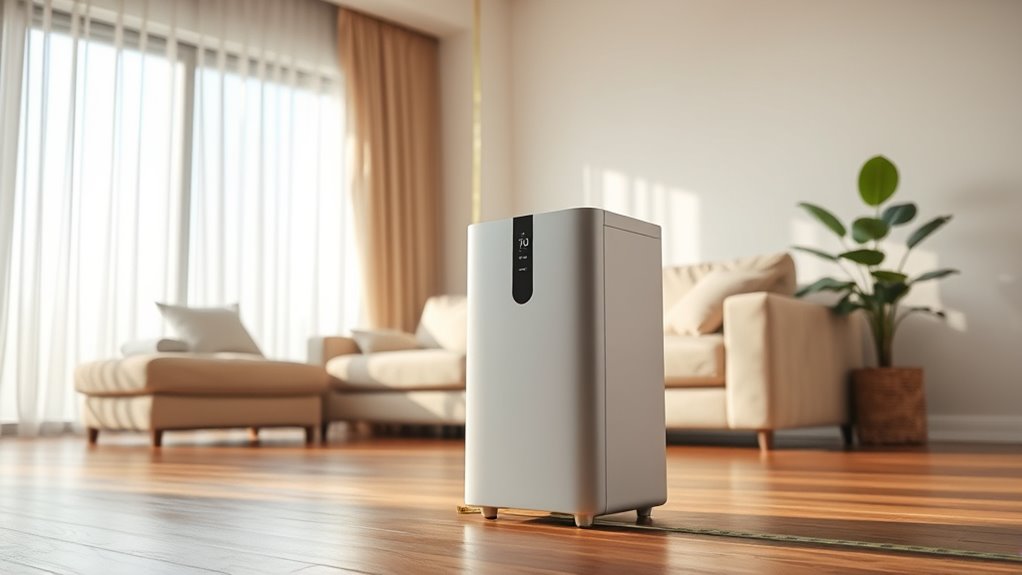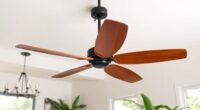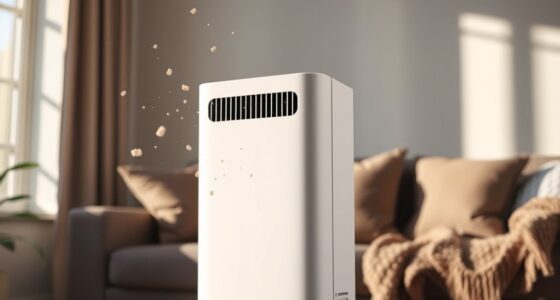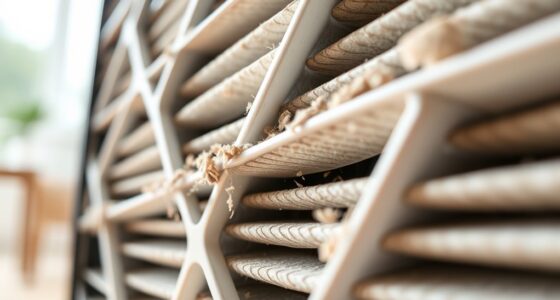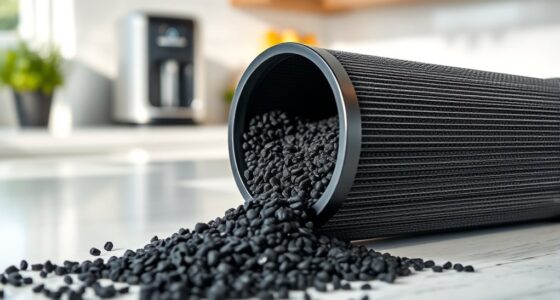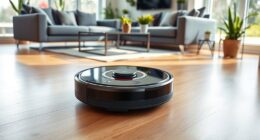To find the right size air purifier, consider your room’s size and air quality needs. A unit with a matching or slightly higher Clean Air Delivery Rate (CADR) ensures pollutants are effectively removed without wasting energy or creating excess noise. Smaller units work quietly in smaller rooms, while larger ones handle bigger spaces better. Proper placement and routine filter maintenance also boost efficiency. Keep these factors in mind—your ideal size and tips for maximum use await beyond this overview.
Key Takeaways
- Match the purifier’s CADR rating to your room’s size for effective air cleaning.
- Consider room square footage to select a unit that provides adequate airflow without overcapacity.
- Smaller rooms typically need lower CADR units for quieter, energy-efficient operation.
- Larger spaces may require higher capacity purifiers, but ensure they do not produce excessive noise.
- Proper placement and regular filter maintenance optimize performance and prevent unnecessary size or power increase.

Choosing the right air purifier size guarantees your space stays clean and fresh. When selecting the perfect unit, you need to contemplate the size of your room and how effectively the purifier can handle the air quality. If you choose a model that’s too small, it won’t clean the air efficiently, leaving pollutants and allergens lingering. Conversely, an oversized purifier might be unnecessary and could lead to higher energy costs. To get it just right, focus on the Clean Air Delivery Rate (CADR) and the room’s square footage, ensuring the purifier can circulate and filter the air adequately.
Once you’ve picked a suitable size, pay attention to filter maintenance. Larger units often require more frequent filter changes because they process more air, but some models are designed to maximize filter lifespan. Regular filter maintenance isn’t just about ensuring maximum efficiency; it also helps keep noise levels down. A clogged or dirty filter can cause the purifier to work harder, increasing operational noise and creating an annoying background hum. Keeping up with filter replacements and inspections ensures that your purifier runs quietly and efficiently, maintaining a peaceful environment in your home or office.
Regular filter maintenance ensures quiet operation and maximum efficiency of your air purifier.
Noise levels are another critical factor when sizing your air purifier. Smaller units tend to be quieter because they don’t need to work as hard to circulate air. Larger models, especially those with high CADR ratings, might generate more noise, which can be disruptive if placed in a bedroom or study. However, many modern purifiers come with multiple fan speed settings, allowing you to choose quieter modes during rest or work hours. When sizing your purifier, look for models that balance airflow capacity with noise level specifications. This way, you won’t sacrifice comfort for cleaner air, and you’ll enjoy a peaceful space without constant background noise.
In addition to size and noise considerations, think about the placement of your air purifier. Proper positioning can enhance its efficiency, meaning you may not need the largest, most powerful model. Keep it away from obstructions and ensure it’s positioned where air can flow freely around it. Also, consider the purifier’s filter maintenance schedule—regular upkeep keeps the unit functioning efficiently and minimizes noise caused by strain on the motor. Taking these factors into account means you’ll select a size that not only fits your room but also operates quietly and efficiently, providing fresh, clean air without constant interruptions or maintenance headaches.
Frequently Asked Questions
Can I Use a Small Purifier for a Large Room Effectively?
Using a small purifier for a large room isn’t very effective because your room size exceeds the purifier’s capacity. If the purifier’s capacity doesn’t match your room size, it won’t filter air efficiently, leaving pollutants behind. To guarantee clean air, choose a purifier with a capacity suited for your room size. This way, you’ll maintain healthy air quality and avoid wasting money on an underpowered device.
How Often Should I Replace Filters in My Air Purifier?
You should replace your air purifier filters based on the filter lifespan and your maintenance schedule. Typically, filters need changing every 6 to 12 months, but this varies with usage and air quality. Check your device’s instructions regularly and monitor for signs like reduced airflow or odors. Staying consistent with filter replacement keeps your purifier running efficiently and guarantees cleaner air in your space.
Do Energy-Efficient Purifiers Perform as Well as Larger Units?
Imagine you buy an energy-efficient purifier for a small bedroom; it cleans the air effectively without high energy bills. These units often perform as well as larger models because of advanced filtration and design, though they may produce slightly higher noise levels. Energy efficiency doesn’t mean sacrificing performance—many compact, efficient purifiers deliver excellent air quality while saving you money and reducing noise concerns.
Is a Higher CADR Always Better for Air Purification?
A higher CADR doesn’t always mean better air purification if it doesn’t match your room’s size. Focus on air exchange rates and CADR efficiency to guarantee your purifier effectively cleans the air. An overly powerful unit could produce unnecessary noise and energy use, while a smaller one might underperform. Choose a purifier with a suitable CADR for your room to optimize air exchange and maintain healthy air quality.
Can Multiple Small Purifiers Outperform a Single Large One?
Multiple small purifiers can sometimes outperform a single large one if they provide better room coverage and target different areas effectively. This setup often extends filter lifespan, since filters work less hard individually. However, managing multiple units can be more complex and costly. Consider your space layout and airflow needs carefully, balancing the benefits of targeted purification against convenience and maintenance.
Conclusion
Now that you know how to size your air purifier, imagine breathing in air so pure it feels like you’ve just stepped into a mountain summit—crisp, fresh, and utterly pure. Your space will transform into a sanctuary, where every breath banishes dust, allergens, and pollutants like a superhero wielding a mighty purifier. Get the perfect size, and watch your home become a fortress of clean air—so powerful, even the tiniest particles stand no chance!
